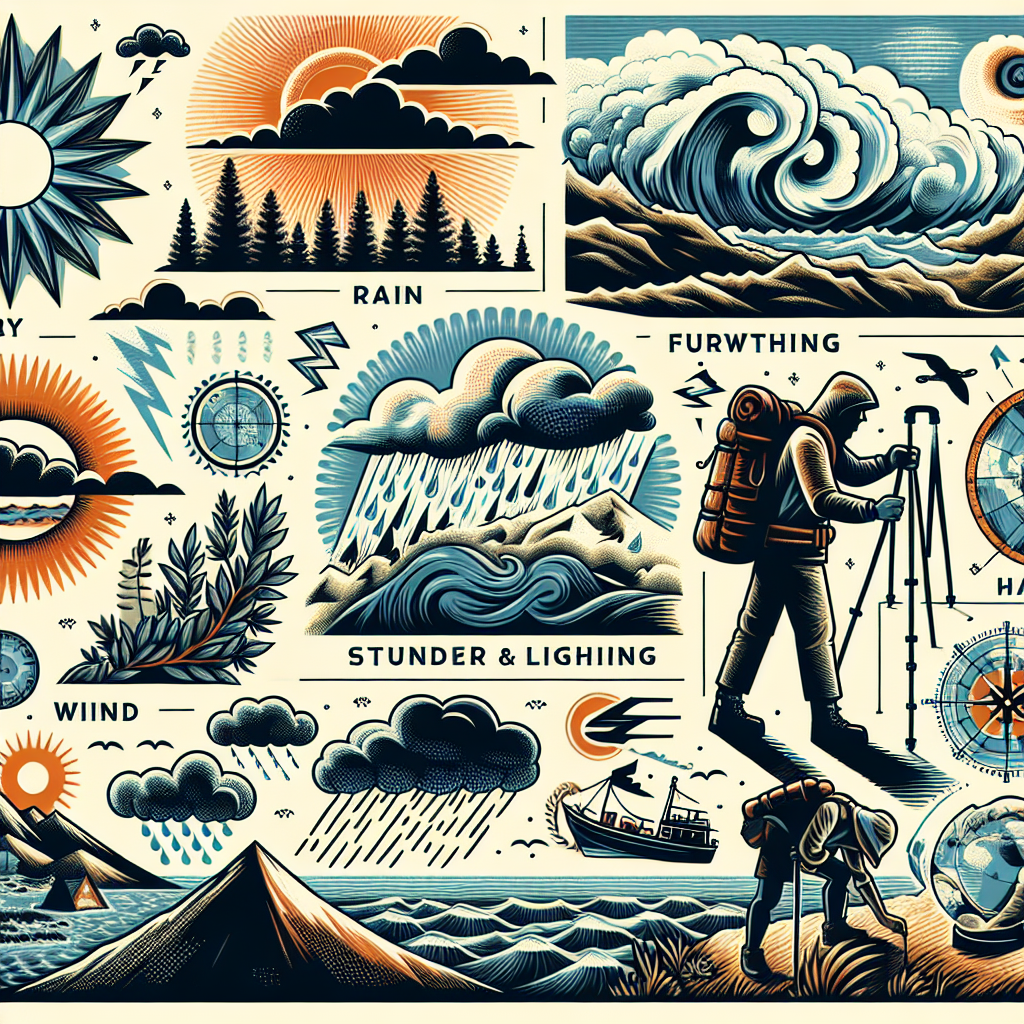In the article “Recognizing Weather Patterns for Survival,” you will learn about the crucial skill of identifying weather patterns to ensure your safety and well-being in various outdoor situations. Understanding how to interpret the clouds, wind, temperature changes, and other indicators will equip you with the knowledge to make informed decisions and plan accordingly. Whether you’re an avid hiker, camper, or simply a curious weather enthusiast, this article will provide you with valuable insights on recognizing weather patterns for your survival.
Importance of Recognizing Weather Patterns
Weather patterns play a critical role in our daily lives, impacting everything from our personal safety to the planning of outdoor activities. By understanding and recognizing these patterns, we can better prepare for natural disasters and ensure our well-being in various weather conditions. In this comprehensive article, we will explore the importance of recognizing weather patterns, how to understand them, signs of impending weather changes, survival scenarios related to weather, equipping ourselves for weather survival, building weather prediction skills, seeking professional weather advice, and preventing weather-related injuries and illnesses.
Understanding Weather Patterns
Meteorological Factors
To recognize weather patterns, it is crucial to understand the various meteorological factors that contribute to them. These factors include temperature, air pressure, humidity, wind patterns, and precipitation. By learning about these elements, you can begin to identify patterns in weather behavior and make informed predictions.
Global Climates
Weather patterns are also influenced by global climates. The Earth is divided into distinct climate zones, such as tropical, temperate, and polar regions. Each climate zone has its characteristic weather patterns, such as monsoons in the tropics or frequent cold fronts in polar regions. By familiarizing yourself with global climate patterns, you can gain insights into regional weather trends.
Local Weather Variations
While global climates provide a broader understanding, local weather variations are equally important to recognize. Factors like geography, proximity to bodies of water, elevation, and terrain can significantly influence local weather patterns. For example, coastal regions often experience more temperate climates due to the moderating effect of the ocean. Understanding these local variations can help you prepare for specific weather conditions in your area.

Recognizing Weather Patterns
Observing Cloud Formations
Cloud formations can provide valuable insights into impending weather changes. Different types of clouds, such as cumulus, stratus, and cirrus, indicate different weather conditions. For example, towering cumulonimbus clouds can signify an approaching thunderstorm. By regularly observing cloud formations, you can develop the ability to predict the weather accurately.
Identifying Wind Directions
Wind direction is a crucial factor in determining weather patterns. Understanding how wind currents move can give you a sense of the weather conditions heading your way. An abrupt shift in wind direction can signal an approaching cold front or storm system. By observing wind direction, you can anticipate changes in weather and take necessary precautions.
Monitoring Barometric Pressure Changes
Barometric pressure refers to the weight of the atmosphere pressing down on the Earth’s surface. Changes in barometric pressure often accompany weather shifts. A quick drop in pressure indicates an approaching storm, while a rise in pressure suggests fair weather. By monitoring these changes using a barometer, you can forecast weather patterns accurately.
Noticing Temperature Fluctuations
Temperature fluctuations can provide valuable information about imminent weather changes. A sudden drop in temperature can indicate the approach of a cold front, while a rapid increase may suggest the arrival of a heatwave. Monitoring temperature changes can help you anticipate weather conditions and adjust your plans accordingly.
Watching for Precipitation
Precipitation, such as rain, snow, or hail, is a clear indicator of weather patterns. By observing the onset, intensity, and duration of precipitation, you can gain insights into weather trends. For example, a sudden increase in rainfall may indicate an approaching storm. Monitoring precipitation patterns can help you make informed decisions about outdoor activities.
Detecting Atmospheric Instability
Atmospheric instability refers to an atmosphere’s tendency to create severe weather conditions. Signs of instability include dark clouds, gusty winds, and rapid changes in temperature or humidity. By recognizing these signs, you can anticipate turbulent weather and take necessary precautions.
Tracking Seasonal Changes
Seasonal changes have a significant impact on weather patterns. Understanding the typical weather conditions during each season in your region can help you plan and prepare accordingly. For example, summer often brings hot and sunny weather, while winter may bring cold temperatures and snow. By tracking seasonal changes, you can be prepared for the specific weather challenges each season presents.
Analyzing Satellite and Radar Images
In the digital age, satellite and radar images have become valuable tools for recognizing weather patterns. These images provide real-time data on cloud formations, precipitation, and storm systems. By analyzing these images, you can gain a more comprehensive understanding of current and future weather conditions. Weather apps and websites often provide access to satellite and radar images, making them easily accessible for anyone seeking weather information.
Signs of Impending Weather Changes
Storm Clouds and Thunderheads
One of the most apparent signs of impending severe weather is the presence of dark storm clouds and thunderheads. These clouds often appear dense and towering, indicating that a storm is approaching. Thunderheads, characterized by their large size and cauliflower-like shape, are a definite sign that thunderstorms are imminent. If you notice such cloud formations, it is essential to seek shelter and prepare for potential severe weather.
Shift in Wind Patterns
A sudden shift in wind patterns can be an early indication of changing weather conditions. For example, a notable shift from a prevailing southerly wind to a northerly wind may suggest the approach of a cold front. By paying attention to wind shifts, you can anticipate the weather changes that may follow.
Rapid Barometric Pressure Drop
A rapid drop in barometric pressure is often a strong indicator of an approaching storm system. When the pressure starts falling quickly, it signifies that the atmosphere is becoming more unstable, potentially leading to severe weather. Monitoring barometric pressure with a barometer allows you to recognize these drops and prepare for the stormy weather that may follow.
Sudden Temperature Shifts
A sudden, significant shift in temperature can indicate a significant weather change. For instance, if you experience a sudden drop in temperature, it may mean that a cold front is moving into the area. Conversely, a sudden rise in temperature could signal an approaching heatwave or a summer storm. By staying alert to sudden temperature shifts, you can adapt your plans and ensure your comfort and safety.
Increase in Humidity Levels
When humidity levels rise rapidly, it often suggests the approach of moisture-laden air and potentially stormy conditions. High humidity coupled with rising temperatures can create an environment favoring thunderstorm development. Paying attention to changes in humidity can help you anticipate the likelihood of rain or other stormy weather.
Unusual Animal Behaviors
Animals have a remarkable ability to sense changes in weather patterns. If you notice unusual behavior in animals, such as birds flying low to the ground or cows seeking shelter, it could be a sign of impending severe weather. Animals often have heightened instincts for detecting changes in atmospheric conditions, making them reliable indicators of approaching storms.
Visible Changes in the Sky
Visible changes in the sky, such as darkening or a greenish hue, can signify approaching severe weather. When the sky begins to darken rapidly, it indicates the potential for thunderstorms or other severe weather phenomena. Additionally, a greenish tinge in the sky often occurs before tornadoes. By staying attuned to visible changes in the sky, you can be prepared for any impending severe weather events.

Weather Patterns and Survival Scenarios
Surviving Extreme Heat
In survival scenarios involving extreme heat, it is crucial to take proactive measures to stay safe. This includes seeking shade, staying hydrated, and wearing lightweight, breathable clothing. Understanding the signs of heat exhaustion and heatstroke, such as dizziness, nausea, and confusion, is vital for early detection and prompt treatment.
Coping with Cold and Snow
Surviving in cold and snowy conditions requires appropriate clothing and gear, such as insulated layers, waterproof outerwear, and insulated footwear. Building a shelter and using suitable sleeping supplies, such as cold-weather sleeping bags, helps retain body heat. Proper nutrition and hydration are also vital for maintaining energy levels and preventing hypothermia.
Preparing for Heavy Rain and Flooding
In flood-prone areas, it is crucial to prepare for heavy rainfall by having a disaster kit with essentials such as food, water, and a battery-powered radio. Understanding flood evacuation routes and knowing how to swim can also be life-saving. Avoiding floodwaters and moving to higher ground when instructed by authorities is critical for personal safety.
Navigating Strong Winds and Tornadoes
Strong winds and tornadoes can be extremely dangerous, so it is crucial to have a plan in place. Identifying safe shelters, such as basements or interior rooms without windows, is essential. Staying informed through weather alerts and having emergency supplies, including a first aid kit and flashlight, is vital for navigating these severe weather events.
Dealing with Thunderstorms and Lightning
When thunderstorms approach, seeking shelter indoors or in a substantial, enclosed vehicle is essential. Avoiding open areas, tall objects, and bodies of water can help reduce the risk of lightning strikes. Understanding how to administer CPR and basic first aid is also valuable in case of emergencies during thunderstorms.
Preparing for Hurricanes and Typhoons
Preparing for hurricanes and typhoons involves creating an emergency plan, securing your home, and having a disaster supply kit with food, water, and essential supplies. Following evacuation orders and relocating to designated shelters can be life-saving. Staying informed through trusted weather sources and maintaining communication with loved ones is crucial during these severe weather events.
Surviving Blizzards and Avalanches
In blizzard conditions, it is crucial to stay indoors and avoid unnecessary travel. Ensuring your home is well-insulated, having a backup heating source, and sufficient food and water supplies are important for survival. Understanding the signs of avalanche-prone terrain and carrying necessary safety gear, such as avalanche transceivers and shovels, is essential for winter backcountry travel.
Preparing for Droughts
During periods of drought, it is essential to conserve water and practice water-efficient behaviors. This can include reducing water usage, maintaining a water storage system, and modifying landscaping to be more drought-resistant. Understanding fire safety and adhering to fire restrictions can also help prevent wildfires in dry conditions.
Equipping Yourself for Weather Survival
Appropriate Clothing and Gear
Having the appropriate clothing and gear for different weather conditions is vital for weather survival. This includes items like waterproof jackets, insulated layers, sturdy boots, and sun-protective clothing. Having the right gear, such as a compass, map, and headlamp, enhances your ability to navigate and stay safe.
Emergency Shelter and Sleeping Supplies
In emergency situations, having access to emergency shelter and sleeping supplies can be life-saving. This can include items like tents, sleeping bags, emergency blankets, and waterproof tarps. Additionally, learning basic survival skills like building shelters can help you adapt to unforeseen circumstances.
Food and Water Storage
Having an adequate supply of food and water is crucial during weather-related emergencies. This can include non-perishable food items, water purification tablets, and water storage containers. Understanding how to safely store food and prevent dehydration is essential for weather survival.
Communication and Navigation Tools
Maintaining communication and having navigation tools are vital in weather survival scenarios. This can involve carrying a fully charged mobile phone, a portable charger, and a weather radio. Additionally, having a compass and up-to-date maps can help you find your way in unfamiliar terrain.
Building Weather Prediction Skills
Studying Local Weather Patterns
To develop weather prediction skills, studying local weather patterns is essential. This can involve keeping a weather journal, noting temperature changes, precipitation patterns, and wind directions. Over time, you will begin to recognize patterns and make more accurate weather predictions.
Gaining Knowledge about Cloud Types
Cloud types provide valuable information about weather conditions. Learning about the different types of clouds, such as cumulus, stratus, and cirrus, can help you anticipate changes in weather. Online resources, field guides, and weather books are excellent sources for expanding your knowledge of cloud types.
Understanding Weather Symbols and Indicators
Weather symbols and indicators are used in weather forecasts and reports. Familiarizing yourself with these symbols, such as raindrops or lightning bolts, helps you understand the predicted weather conditions. Weather websites and books often provide explanations of commonly used weather symbols.
Reading Weather Forecast Sources
Reading weather forecasts from trusted sources helps improve your weather prediction skills. Understanding how to interpret forecast data, such as temperature trends and chance of precipitation, enables you to plan accordingly. Local meteorological offices, weather websites, and apps are reliable sources for obtaining weather forecast information.
Practicing Weather Observation and Analysis
The key to building weather prediction skills is consistent practice in weather observation and analysis. Take every opportunity to observe the weather, note changes, and analyze the patterns you observe. Over time, your ability to predict weather conditions accurately will improve.
Seeking Professional Weather Advice
Consulting Local Meteorologists
In situations where accurate and timely weather information is crucial, consulting local meteorologists is highly recommended. Meteorologists have the expertise necessary to interpret complex weather patterns and provide reliable forecasts. Local television and radio stations often feature meteorologists who can provide up-to-date weather information specific to your region.
Utilizing Weather Apps and Websites
Weather apps and websites provide accessible and real-time weather information. These resources often offer hourly and extended forecasts, radar and satellite imagery, severe weather alerts, and more. Utilizing these apps and websites allows you to stay informed and make informed decisions based on current weather conditions.
Monitoring Emergency Alert Systems
Emergency alert systems, such as the Emergency Alert System (EAS) or the Wireless Emergency Alerts (WEA), provide critical weather-related information and immediate warnings. This can include severe weather alerts, evacuation notices, and other emergency notifications. Staying tuned to these alert systems helps ensure your safety during weather-related emergencies.
Preventing Weather-related Injuries and Illnesses
Recognizing Signs of Hypothermia and Frostbite
In cold weather conditions, it is essential to recognize the signs of hypothermia and frostbite. Symptoms of hypothermia include shivering, confusion, and drowsiness, while frostbite manifests as numbness, discoloration, and waxy skin. Promptly addressing these conditions and seeking medical attention is vital to prevent long-term damage.
Avoiding Heat Exhaustion and Heat Stroke
To avoid heat exhaustion and heatstroke, it is crucial to stay hydrated, seek shade, and take frequent breaks in extreme heat. Symptoms of heat exhaustion include excessive sweating, dizziness, and nausea, while heatstroke manifests as a throbbing headache and loss of consciousness. Understanding the signs and taking immediate action can prevent life-threatening situations.
Protecting Against Sunburn and UV Radiation
Protecting yourself against sunburn and harmful UV radiation is essential for long-term skin health. Applying broad-spectrum sunscreen, wearing protective clothing, and seeking shade during peak sun hours can reduce the risk of sunburn and related skin conditions like skin cancer.
Preventing Dehydration and Heat-related Illnesses
Staying hydrated is vital in hot weather to prevent dehydration and heat-related illnesses. Drinking plenty of water, avoiding excessive caffeine and alcohol, and replenishing electrolytes through sports drinks are effective prevention measures. Recognizing the signs of dehydration, such as dark urine and fatigue, allows for prompt action.
Taking Precautions against Lightning Strikes
To reduce the risk of lightning strikes, it is crucial to seek shelter indoors or in an enclosed vehicle during thunderstorms. Avoiding open areas, tall objects, and bodies of water helps lower the chances of being struck by lightning. Taking these precautions significantly enhances personal safety during severe thunderstorms.
Preventing Flood-related Dangers
In flood-prone areas, preventing flood-related dangers is critical for personal safety. Avoiding driving through flooded roads, staying away from swollen rivers or streams, and moving to higher ground during flood warnings are important precautions. Floodwaters can be deceptively powerful, and it is essential to prioritize safety by avoiding flooded areas.
Conclusion
Recognizing weather patterns is of utmost importance for personal safety and preparedness. By understanding meteorological factors, global climates, and local variations, you can gain insights into weather behaviors. Recognizing signs of impending weather changes, handling survival scenarios, equipping yourself with essential items, building weather prediction skills, seeking professional advice, and taking preventive measures against injuries and illnesses ensure your well-being in various weather conditions. By being proactive and informed, you can navigate weather-related challenges with confidence and stay safe in any scenario.

